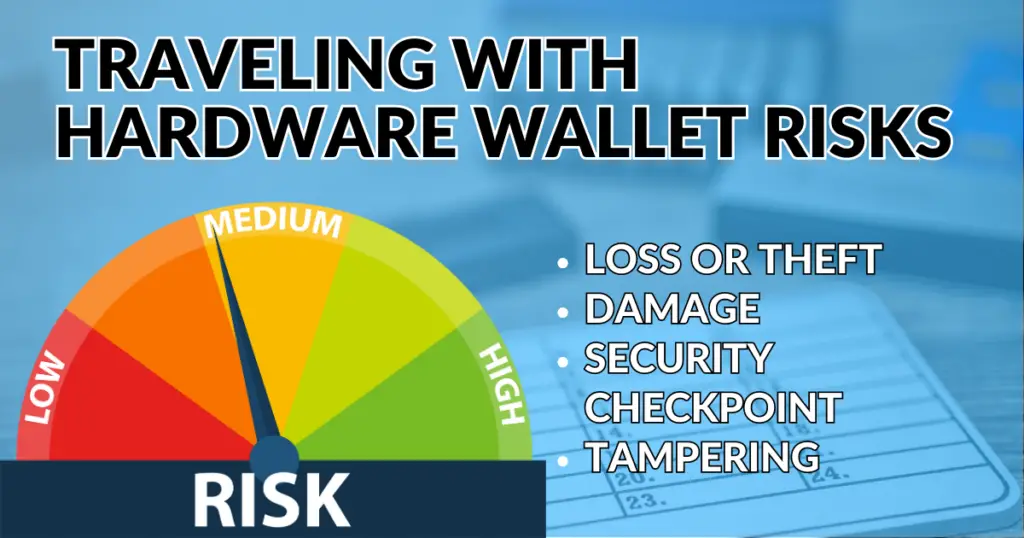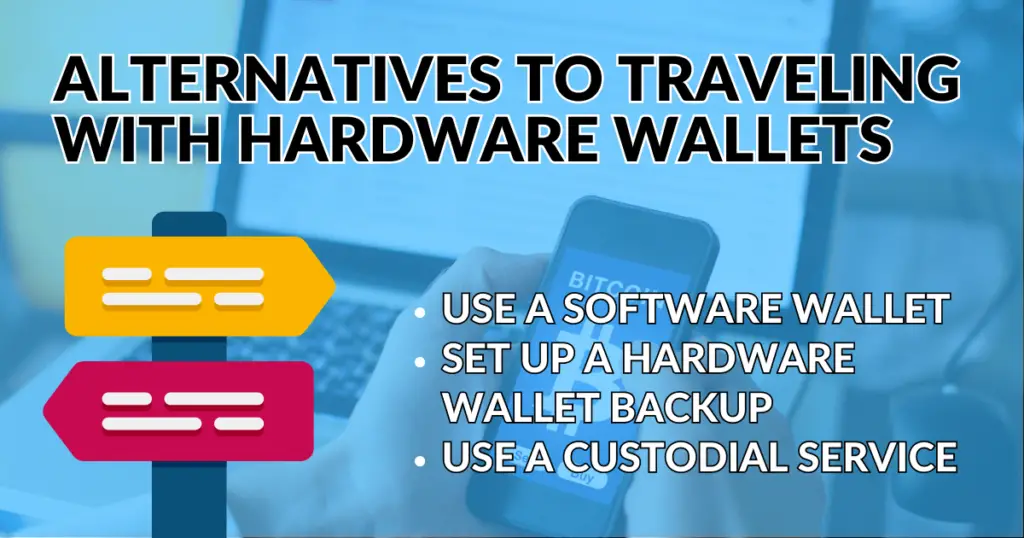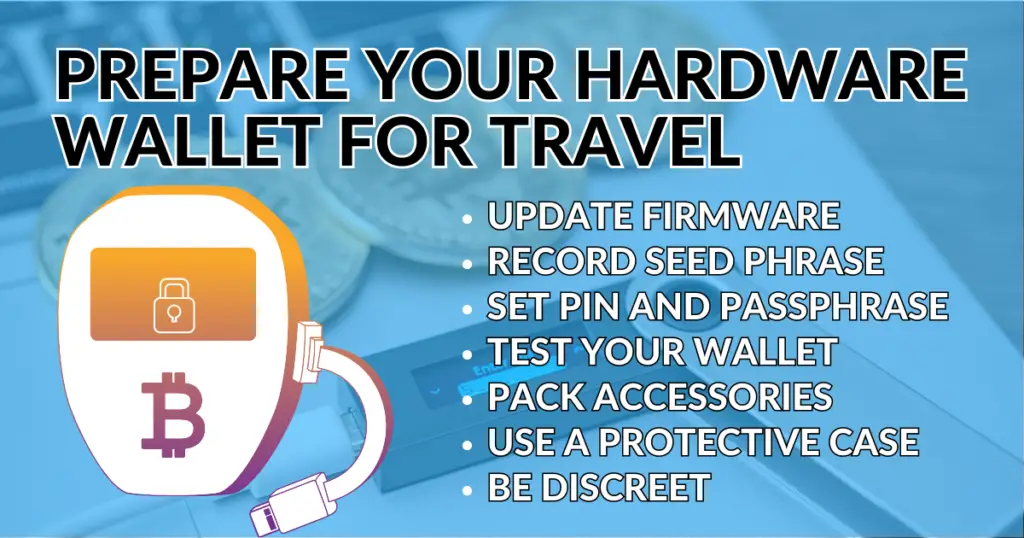Are you debating whether or not you should travel with a hardware wallet? I’ve debated the same thing. After all, we use our wallets to store extremely valuable assets. This guide will help you determine if traveling with your hardware wallet is right for you.
Here’s what you’ll learn:
Should You Travel With A Hardware Wallet?
Traveling with your hardware wallet is risky since it could easily be lost, stolen, or damaged. If you want to travel with your hardware wallet, ensure it’s locked at all times. Only unlock it if you decide to use it.
As long as your hardware wallet is locked, it remains inaccessible even if someone were to get ahold of it. Likewise, if your wallet is lost or stolen that doesn’t mean your assets disappear.
It just means you have to buy a new wallet. But as long as you have your secret recovery phrase, you can access your funds from your lost wallet, using your new wallet.
That said, if you happen to lose your wallet you should transfer your assets to a new wallet (one that uses a new seed phrase, not just a new device) as soon as possible.
This will prevent anyone from stealing your funds. Again, I wouldn’t worry about your funds being stolen too much as long as your wallet was locked when you lost it.
Most quality hardware wallets are designed to prevent anyone from accessing your device if they don’t know the secret recovery phrase. This is achieved through various security elements including secure chips, custom operating systems, PIN codes, and biometric authentication.
In fact, some of the safest hardware wallets even have a “self-destruct mechanism” that erases your wallet if too many failed attempts occur.
The moral of the story is; if you decide to travel with your hardware wallet make sure you’re using a safe device and keep it locked at all times when not in use.
Can I Bring My Hardware Wallet on the Plane?
Yes, you can bring a hardware wallet on the plane since the TSA does not prohibit it. However, it could be subject to additional screening so be ready to remove it from your carry-on bag during the screening process.
Because the TSA doesn’t have any specific prohibitions on cold-storage hardware wallets, you can assume they’d be treated similarly to most other electronic gadgets on the list.
After reviewing the TSA’s “What Can I Bring” list, I found a few items that are similar to hardware wallets. From this, we can determine what precautions you might have to take when bringing your device on a plane.
The first item that caught my attention is “Lithium batteries with 100 wat hours or less in a device”.
According to the TSA, uninstalled lithium-ion batteries such as power banks and charging cases must be carried in your carry-on baggage only.
Also, rechargeable lithium-ion batteries are limited to a rating of 100 watt hours (Wh) per battery. That’s equal to 27,000mAh.
For comparison, most hardware wallets are nowhere near that level of mAh. The Ledger Stax’s battery is only 200mAh, and the beefier Ngrave Zero is only 1,200mAh. Furthermore, most phones don’t even exceed 5,000mAh.
So it’s safe to say that no hardware wallet is going to exceed the 27,000mAh limit. And even if it did, you could still bring it on your carry-on luggage, just not your checked baggage.
Here is a summary of what the TSA says about portable electronic devices, with internal batteries.
Most consumer personal electronic devices containing batteries are allowed in carry-on and checked baggage, including cell phones, smartphones, laptops, cameras, tablets, and more.
Devices containing lithium metal or lithium-ion batteries should be carried in carry-on baggage when possible. When in checked baggage, it must be powered off and protected to prevent unintentional activation or damage.
Spare lithium batteries are always prohibited in checked baggage and must be placed in a carry-on, and there are quantity limits for larger batteries. Damaged or recalled batteries and battery-powered devices that can create dangerous heat or sparks are not allowed on board.
Knowing this, it’s a good idea to keep your hardware wallet in your carry-on during your flight, rather than leaving it in checked luggage.
Risks of Traveling with Your Hardware Wallet

There are several risks to consider before deciding to travel with your hardware wallet.
Loss or theft
Losing or having your hardware wallet stolen is the greatest risk as this poses the largest threat to your funds. If your wallet isn’t locked and someone gets ahold of it, they can transfer your crypto assets to their own wallet in minutes.
When traveling, things tend to get lost easier as it can be more difficult to keep track of your belongings. Additionally, leaving your wallet in the hotel room or Airbnb poses another risk, as you can’t trust anyone you don’t know.
Plus, the anxiety of not knowing where your hardware wallet is or who has it could ruin your trip if you let it, and that’s no fun.
Damage
When you pack your bags for a road trip or air travel, your wallet may end up in a tight and cramped space, leaving it vulnerable to getting crushed. Hence, traveling with your hardware wallet increases the likelihood of physical damage.
This is especially true if you pack your wallet in your checked luggage. We’ve all seen how airport employees handle our bags—like sacks of potatoes.
Even if you stash your wallet in your carry-on, it still has the potential to be treated as cargo if the overhead bins are full before you board, as you’ll have to let them put your bag under the plane with the checked luggage. Yikes!
Security checkpoints
Although unlikely, certain countries might have restrictions on bringing hardware wallets across their borders. For this to pose any risk, airport officials would first have to know the device is a hardware wallet. If your wallet is subject to additional screening, it could delay your travel plans.
Or worse.
If an airport employee wants to confiscate something, they can. Even if their reasoning might not be justifiable, it’s still a possibility. Especially if traveling to parts of the world where there are looser government regulations and fewer rules.
Tampering
If someone with malicious intent were to get ahold of your wallet, they could tamper with it, compromising its security and potentially stealing your funds. That’s why it’s important to secure your wallet and use a reputable brand that utilizes various security measures.
Alternatives to Traveling With a Hardware Wallet

Consider traveling with a paper or software wallet as an alternative to your hardware wallet. These options are more discreet, less likely to be damaged, lost, or stolen, and still allow you to access your digital assets on the go.
Here are some additional alternatives to traveling with your hardware wallet.
Use a software wallet
Since most hardware wallets are used solely for storage, consider using a software wallet for any transactions while traveling. Software wallets work similarly to hardware wallets and are stored conveniently on your mobile device or desktop browser.
This means you don’t have to worry about your wallet getting damaged. However, it could still get stolen if the device you have the software installed on were to get stolen.
So again, ensuring your software wallet is protected via a password and biometric authentication is crucial regardless of what type of wallet you’re using.
That said, if you’re buying digital goods on the go, you can still use your software wallet to send your assets to your hardware wallet, even if you don’t have your hardware device with you.
Set up a hardware wallet backup
It’s a good idea to set up a backup wallet and store it in a secure location at home. This will ensure that you have quick access to your funds once you return home and in case of an emergency.
Having a backup wallet also enables you to recover your funds easily if you lose your primary wallet while traveling. Even if you haven’t set up a backup wallet, it’s still wise to have a second wallet prepared in case your main wallet ends up lost or stolen.
Use a custodial service
If you’re only dealing with cryptocurrency, consider using a custodial service while you travel. Most exchanges allow you to store crypto on their platform. While this might not be as secure as using your hardware wallet, you don’t need to carry a physical device with you.
Also, you can still move crypto around and make purchases using a custodial service. However, if you plan to buy, sell, or trade NFTs, you’re going to need access to a non-custodial wallet like MetaMask or your hardware wallet.
How to Prepare Your Hardware Wallet for Travel

Be sure to update the firmware and back up your recovery seed phrase before traveling with your hardware wallet. For added protection, secure your device with a strong password and store it in a protective case during travel.
Update your hardware wallet’s firmware
Ensuring your device’s firmware is up to date is crucial to its overall security. Most hardware wallets need to be connected to a computer for updates. It’s much easier to do this before you travel, versus while you’re on the go.
Ensure your seed phrase is recorded
A seed phrase is a wallet’s most important security aspect. Make sure you have your recovery phrase written down and stored in a secure location before traveling. You’ll need this phrase to recover your assets if your wallet is lost, stolen, or damaged.
Even if you’re not traveling, you should always leave your secret recovery phrase stored in a secure spot. Also, do not store your seed phrase online, on your computer, or on your mobile device as this defeats the purpose of using a hardware wallet.
It must be isolated from the internet to keep it away from potential hacks and scams.
Set a PIN and passphrase
Most hardware wallets come with additional security features you can enable. This includes passphrases, PIN codes, and biometric authentication. Ensuring all these are set up before traveling ensures your wallet will remain secure.
As long as you have these additional security measures set up and you actively using them, you don’t need to worry too much. Even if your wallet is stolen, these features will help keep others out of your wallet and your funds safe.
Test your wallet before traveling
It’s never a bad idea to test your wallet before heading out. Be sure the battery is fully charged, the firmware is up to date (this includes the apps on your wallet), and you have memorized all your passphrases.
Pack any necessary accessories
Make sure to pack all necessary accessories that accompany your wallet. Charging cables, adapters, and protective cases are all accessories you’ll need to bring with you.
In fact, some wallets like the Ledger Nano S Plus won’t function without its power cable considering it doesn’t have a battery, so be sure to double-check check you have everything you need.
Use a protective case
A protective case will prevent your hardware wallet from bouncing around or getting crushed. These cases are made of metal or tough plastic and will keep your device safe, regardless of where you pack it.
Trust me, it’s worth getting a case to keep it safe. It’s also cheaper than having to buy a new wallet if it were to get destroyed while traveling.
Be discreet
Never tell anyone you have a hardware wallet. Be discreet as possible by keeping it tucked away and out of the public’s eyes. Even things like stickers and clothing that showcase your wallet’s brand could draw unwanted attention to you.
Best Hardware Wallet Travel Cases
One of the best ways to keep your hardware wallet safe while traveling is by storing it in a protective case. Here are the best protective cases for nearly any type of hardware wallet and all budgets.
- Ledger Nano X Case $39
- Ledger Nano X Pod $39
- Ledger Nano S Plus Case $39
- Ledger Nano S Plus Pod $39
- Amazon Ledger Nano X & S Plus Compatible Case $13
- CamKix Trezor Hardshell Protective Travel Case $8
- Casematix Crypto Wallet Case (generic) $10
- Casematix Waterproof Hardshell Case (this case is compatible with several hardware wallets) $18
Frequently Asked Questions
What happens if I lose my hardware wallet while traveling?
As long as your device is locked, more than likely it can’t be accessed. You should transfer your assets to a new wallet using your recovery phrase as soon as possible. Ensure the wallet you transfer assets to uses a new recovery phrase.
Do x-ray machines at the airport ruin hardware wallet?
No, x-ray machines will not damage your hardware wallet. That’s why we can put our phones and computers through without any issues. However, a metal detector could.
Are hardware wallets legal to travel with?
Yes, the TSA has no restrictions on traveling with hardware wallets either in your carry-on or checked bags. However, you might need to remove your wallet from your carry-on bag and place it in a separate bin for X-ray screening.
Which countries are risky for traveling with a hardware wallet?
Countries with high levels of theft might be riskier to bring your hardware wallet. Said countries include but are not limited to: Honduras, Venezuela, Papua New Guinea, South Africa, Afghanistan, Guyana, Brazil, Jamaica, Trinidad and Tobago, and Somalia.
